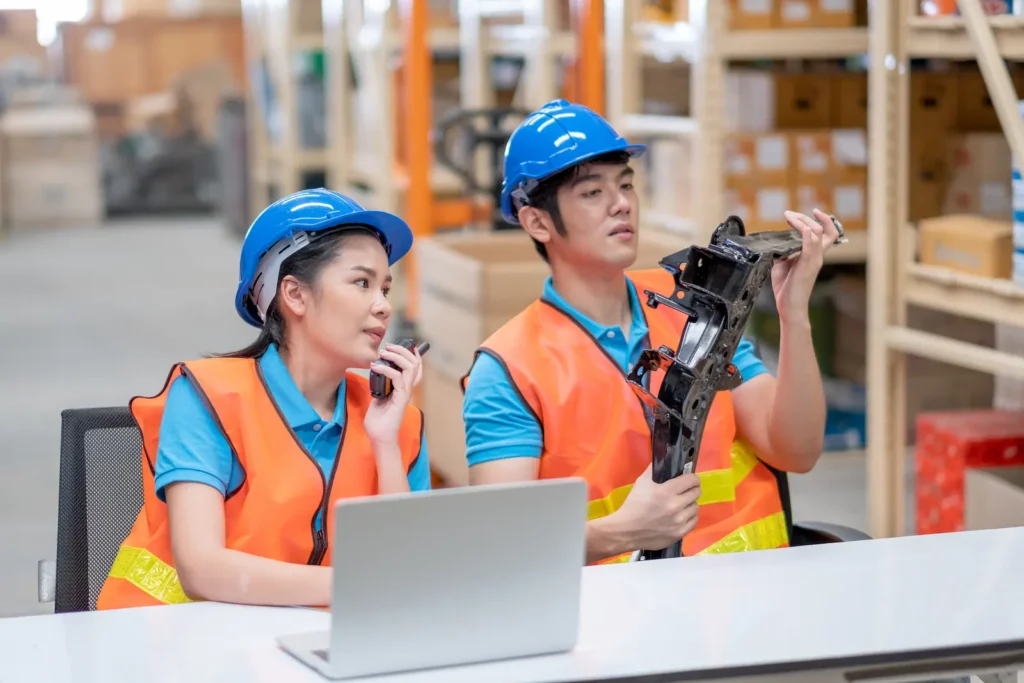Table of Contents
Introduction: Why PSI Inspections Matter
Pre‑shipment inspection (PSI) is the last line of defence between the factory floor and your customer’s unboxing experience. It’s the moment when you verify that a completed batch of goods meets your specifications for quality, safety, functionality and packaging before it leaves China. In a world where a single defect can go viral and a delayed shipment can sink a season, PSI inspection isn’t an optional extra, it’s a business necessity.
Brands importing from China rely on PSI inspections to confirm that the right quantities are ready, that materials match the order, and that critical tests (like fit, finish, function, safety and compliance) have been passed. An effective PSI inspection protects your reputation, reduces returns and ensures you’re not paying for unusable inventory. It also reinforces your relationship with factories by signalling that quality matters. However, many companies still skip or rush through this step, resulting in substandard products and costly recalls.
At Yana Sourcing, we believe pre‑shipment inspections should go beyond ticking boxes. Our name,You Are Not Alone, reflects our commitment to partnering closely with your team and your suppliers to achieve human‑centred manufacturing excellence. We blend empathy and experience with modern tools like digital inspection reports, AI‑assisted quality systems and ESG‑oriented audits. We also recognise that quality is inseparable from ethics and sustainability; a product made with renewable materials like bamboo signals your brand’s values while absorbing carbon during growth.
This guide demystifies PSI inspections in China for the 2025–2030 era. It covers why they’re so important, outlines the steps involved, highlights common pitfalls and shares best practices. We will also explore trends like AI‑driven inspections and the rising importance of ESG compliance. Throughout, you’ll see how Yana’s human‑centred approach and low minimum order quantity (MOQ) flexibility help entrepreneurs and growing brands protect their reputations and delight their customers.

Understanding PSI Inspection: What It Is and What It Isn’t
Pre‑shipment inspection (PSI) is a specific type of quality control (QC) that occurs when production is 100 % complete and at least 80 % of goods are packed and ready for shipment. It is a final check that the products meet contractual specifications and market regulations before your factory releases them to the freight forwarder. PSI inspections can be carried out by your own team, by your sourcing partner or by a third‑party inspection company.
PSI vs. QC vs. QA
It’s easy to confuse terms like quality control and quality assurance. Quality control (QC) refers to the overall set of tests and inspections used to identify defects in production. It includes early sampling, in‑process inspections, final random inspections and laboratory tests. Quality assurance (QA) is the system of processes designed to prevent defects from occurring in the first place: documented procedures, training, supplier audits and corrective action plans. A PSI inspection is one specific tool in the QC arsenal, it’s an on‑the‑ground check performed at the end of production to catch any final non‑conformities.
Who Needs PSI Inspection?
If you source products from overseas factories, you need pre‑shipment inspections. This is particularly true if:
- You are a start‑up or small brand testing a new product line and can’t afford to pay for faulty inventory.
- You don’t have in‑house quality engineers or can’t travel regularly to China.
- Your product will be sold under your own brand name and must meet safety regulations like CE, FCC or CPSIA.
- You want to launch sustainable or ethical products that reflect your values.
Investing in PSI inspections signals professionalism and builds trust with your suppliers. It also reassures your customers that you care about delivering safe, reliable and ethically made goods.

The High Stakes of Pre‑Shipment Inspections
Protecting Your Brand and Customers
Skipping a pre‑shipment inspection exposes you to considerable risk. Without that final quality gate, defects can slip into your shipment and end up in customers’ hands. Negative reviews and returns erode trust quickly. Research shows that inadequate due diligence on suppliers can lead to substandard products, missed deadlines, counterfeit goods and reputational damage. By verifying quality before your products ship, you avoid expensive product launches that fail in the market and protect your brand’s reputation.
Avoiding Costly Delays and Penalties
Missteps in customs documentation or misclassified Harmonized System (HS) codes can cause long delays, fines and unexpected duties. According to import compliance experts, mistakes such as using the wrong tariff codes or incomplete paperwork regularly lead to shipment delays and penalties. PSI inspections allow you to verify that all labeling, documentation and packaging meet destination country requirements, including product safety certifications. Catching these issues before your goods leave the factory ensures smoother customs clearance and reduces costs.
Meeting Rising Consumer Expectations
Consumers today value transparency, safety and sustainability. They care about how products are made and whether workers are treated fairly. By integrating ESG audits and sustainable material checks into your PSI process, you align your supply chain with these expectations. Many Chinese factories now undertake ESG audits and AI‑assisted quality control systems. Aligning with forward‑thinking suppliers helps you tell a positive story and attract ethical consumers.
Balancing Speed and Quality
The pre‑shipment stage often feels rushed. You need your goods on the next ship or plane, but hurrying through inspections can lead to expensive mistakes. A PSI inspection helps you find a balance. It ensures your order is truly ready for shipment and reduces the risk of last‑minute surprises. Working with a reliable inspection partner who understands the urgency of supply chains means you can keep lead times short without sacrificing quality.

Steps of an Effective PSI Inspection
Conducting a PSI inspection is more than checking boxes; it’s a systematic process designed to verify product quality, compliance and packaging. Here are the typical stages:
1. Preparation
Before the factory finishes production, you (or your inspection partner) agree on the inspection criteria. This includes:
- Inspection scope – which features and functions will be checked?
- Sampling plan – how many units should be inspected? Sampling sizes are often based on the AQL (Acceptable Quality Limit) standard.
- Testing equipment – are special instruments needed for performance tests, such as torque testers or barcode readers?
- Documentation – what certificates, labels and packing details must be verified?
Communicate these requirements in writing and confirm them in both English and Chinese. This prevents confusion on the day of inspection.
2. Arrival and Product Count
Inspectors arrive at the factory or warehouse when production is complete and goods are at least 80 % packed. The first task is to verify the quantity and packing status. They count cartons, confirm the order number, and check that the right product codes are on labels. If quantities are off or packaging is incomplete, the inspection may be rescheduled.
3. Sampling and Workmanship Check
Using the agreed sampling plan, inspectors randomly select units to examine. They look at overall appearance, materials and workmanship. Are there scratches, dents, loose threads or colour mismatches? For electronics, they may do basic functional tests like plugging in a device, turning it on and checking that buttons and displays work. For garments, they check seams, zippers, labels and measurements.
4. Dimensional and Functional Tests
Measurements are taken using callipers, rulers or gauges. For products with moving parts or mechanical functions, inspectors perform performance tests. For example, they might test the suction of a vacuum cleaner, the brightness of a flashlight, or the responsiveness of a touchscreen. If the products are subject to mechanical stress (like folding, twisting or stretching), they perform simple stress tests to see if anything breaks.
5. Compliance Verification
If the product falls under regulations like CE, FCC, CPSIA or RoHS, the PSI inspection includes checking compliance documents. Inspectors verify that required marks are on the product and packaging, and that certificates of conformity match what’s being shipped. For children’s products, they may check for choking hazard warnings or age labels. For electronics, they check that serial numbers and power ratings are correct.
6. Packaging and Labelling
Proper packaging protects products in transit and prevents damage. Inspectors verify that cartons are sturdy, that goods are wrapped or bagged correctly, and that packing materials are dry and clean. They check that barcodes, FNSKU labels and carton markings match your requirements. They also ensure the right number of units are packed in each carton and that there are no mixed items.
7. Reporting and Decision
After the inspection, you receive a detailed report with photos, measurements, defect counts and notes on compliance. If the defect rate is above the agreed acceptance level, you must decide whether to rework the goods, ship them as is, or cancel the order. Your inspection partner can guide you on next steps and negotiate with the factory.
Common Mistakes That Compromise PSI Inspections
Even experienced importers sometimes make mistakes during PSI inspections. Being aware of these pitfalls helps you avoid costly errors:
Rushing Through the Process
There’s a tendency to treat PSI inspections as a formality. Pressures from clients and shipping deadlines can make you want to “just get it over with.” But skipping critical tests or skipping the sampling plan will come back to haunt you. Remember, the inspection is your last chance to catch problems before shipping.
Focusing Only on Finished Appearance
Inspectors sometimes focus on cosmetic defects—scratches or blemishes—and overlook functional issues. This is particularly risky for electronics, appliances or any product where safety and performance matter. Always ensure functional tests are part of the inspection plan.
Over‑reliance on Factory Self‑Reporting
Some factories claim to have in‑house inspection teams and send you their own reports. While it’s great when suppliers have quality programmes, self‑reporting isn’t enough. The biggest risk is that suppliers may overlook defects or fudge numbers to avoid rejection. Independent or third‑party inspections provide an unbiased assessment.
Ignoring Sustainability and ESG Metrics
Sustainability is part of quality. Using materials like bamboo, which is renewable and absorbs carbon dioxide during growth, and ensuring factories meet environmental standards are now integral to product quality. A PSI inspection should verify material sources and check that waste disposal and packaging align with your ESG goals.
Not Verifying Documentation
Documentation errors can delay shipments and lead to fines. Inspectors should check that all labels, barcodes, shipping marks and certificates are correct. They should confirm that the HS code on the invoice matches the product and that export licences or declarations are valid.
Yana’s Human‑Centred Approach to PSI Inspection
At Yana Sourcing, PSI inspections are not a commodity service; they are part of our human‑centred sourcing philosophy. Here’s how we do it differently:
1. Building Trust and Empathy
We start by understanding your product vision and the purpose behind it. Instead of only focusing on defects, we build relationships with your supplier and their workers. We celebrate craftsmanship, help train factory staff and share feedback constructively. When workers feel respected, they are more likely to care about your product and raise concerns before they become problems.
2. Integrating ESG and Sustainability
We believe quality must serve people and planet. That means verifying not only technical specifications but also labour conditions and environmental impacts. We audit factories for energy use, waste management and safe working conditions. We recommend sustainable materials like bamboo, recycled metals and biodegradable plastics. By aligning your brand with responsible sourcing, you attract conscious consumers and stand out in crowded markets.
3. Leveraging Technology
Our inspections use digital tools like mobile apps for real‑time data collection, automated cameras for accurate measurement and AI‑assisted analysis. We share detailed reports with photos and videos within hours of the inspection. We also use AI to spot patterns in defect data and predict potential issues. These tools complement human judgement and make inspections more reliable.
4. Low MOQ and Scalability
Yana specialises in helping small and medium‑sized businesses who don’t have massive budgets. We negotiate low MOQs with factories so you can place small orders and test the market without huge upfront costs. We still provide full PSI inspections for these small orders. When your product succeeds, we help you scale up while maintaining quality and sustainability.
5. Transparent Communication
We send regular updates, photos and videos as goods are produced, packed and inspected. If a problem arises, we alert you immediately and propose solutions. We don’t hide information or sugar‑coat issues. Our goal is to make you feel like you’re present in the factory even if you’re on the other side of the world.
Tools and Best Practices for PSI Inspection
The best PSI inspections combine good people, reliable processes and modern tools. Here are our recommended practices:
Use Standard Sampling Plans
Adopt internationally recognised sampling standards such as ISO 2859‑1 or ANSI/ASQ Z1.4. Choose the right AQL levels for your product—0.65 or 1.0 for critical items (like medical equipment) and 2.5 or 4.0 for general consumer goods. Setting the correct defect tolerance keeps expectations clear.
Create Detailed Checklists
A comprehensive inspection checklist ensures nothing is overlooked. It should include workmanship criteria, functional tests, packaging requirements, labeling details, documentation checks and sustainability audits. Translate it into Chinese and provide physical or digital reference samples.
Schedule Early and Confirm Production Status
Arrange the PSI inspection when production is about 80 % complete. Confirm that the goods will be ready and packed by the inspection date. If the factory is behind schedule, reschedule rather than rushing through partially finished goods.
Use Digital and Video Tools
Record inspection results in real time using mobile apps and cloud databases. Video calls allow you to observe critical tests, ask questions and give real‑time feedback. Digital tools reduce data entry errors, speed up reporting and give you a visual record.
Collaborate with Accredited Labs
For regulated products, tests like electrical safety, chemical content, flammability or food contact must be done in accredited laboratories. Plan these tests in advance and integrate them into the overall QC timeline.
Follow Up with Root Cause Analysis
If your PSI reveals defects above your tolerance, don’t just rework and move on. Conduct a root cause analysis with the factory to understand why defects occurred and how to prevent them in future. Document findings and update your inspection checklist.
Build Long‑Term Supplier Partnerships
Quality improves when suppliers feel valued. Instead of switching factories at the first defect, work with them to improve processes. Offer feedback, training and fair prices. Your investment in the relationship pays off in reduced defects and better collaboration.
Trends and Innovations Shaping PSI Inspection
AI‑Driven Inspections
Artificial intelligence is transforming quality control by analysing images, identifying anomalies and predicting potential defects. In a PSI context, AI can automatically measure dimensions, check alignment, or detect surface flaws. It also helps detect patterns across batches, so you can spot systemic issues and address them quickly. This doesn’t replace human inspectors but augments their capabilities.
ESG Compliance and Ethical Audits
Buyers and regulators are placing more emphasis on ethical and environmental practices. ESG audits, which examine labour conditions, carbon emissions, water use and waste management, are becoming a standard part of supplier vetting. Integrating ESG checks into PSI ensures your products meet ethical standards and helps you tell a compelling story to consumers.
Sustainable Materials and Circularity
Materials like bamboo, hemp, mycelium leather and recycled aluminium are gaining popularity because they reduce reliance on fossil fuels and store carbon. These materials require special handling and inspection procedures, moisture content, curing processes and durability must be checked carefully. PSI inspections must adapt to these new material requirements.
Supply Chain Diversification and Resilience
Many brands are adopting a “China + 1” strategy, sourcing from multiple countries to reduce risk. This means PSI inspections must extend to new regions like Vietnam, Thailand or India. Sourcing partners should have networks of inspectors across these regions and coordinate consistent inspection standards.
Remote and Virtual Inspection
Travel restrictions and cost pressures have accelerated the adoption of remote inspections. Using high‑definition cameras, real‑time video calls and digital checklists, inspectors can guide factory staff remotely and verify key tests. While not a complete substitute for on‑site checks, virtual inspections are a good option for low‑risk products or ongoing quality monitoring.
Real‑World Scenarios: How PSI Saves the Day
Scenario 1: Launching a Health and Wellness Product
A startup wanted to launch an ergonomically designed foam roller for home workouts. They were concerned about latex allergies and wanted to ensure consistent hardness across units. Yana organised a pre‑shipment inspection that included foam density testing, hardness checks and labeling verification. Inspectors measured the diameter and firmness of randomly selected rollers and confirmed that the “latex‑free” labels were visible. A few units had minor defects in surface finish; the factory reworked those before shipping. The brand launched on schedule with zero complaints about allergens or firmness.
Scenario 2: Small Accessories Brand Avoids Costly Returns
A young fashion accessories brand placed a 500‑unit order for vegan leather wallets. They were tempted to skip a PSI because of time and budget constraints, but Yana insisted on a final check. Inspectors discovered that 7 % of wallets had misaligned stitching, and a few had incorrect logos. The factory fixed the defects and re‑stitched the logos within two days. The brand saved thousands by avoiding returns and maintained its reputation for quality craftsmanship.
Scenario 3: Reusable Packaging for Zero‑Waste E‑commerce
An eco‑minded e‑commerce company wanted to ship its products in reusable packaging made from recycled plastics and bamboo fibre. The material needed precise adhesive bonding and moisture‑resistant coatings. Yana designed a PSI checklist focusing on material composition, adhesive strength and water absorption. Inspectors used moisture metres to check dryness and conducted drop tests. The inspection revealed that the first batch wasn’t fully cured, risking mould growth. Production was halted, the curing process was adjusted and the new batch passed inspection. The company launched its zero‑waste packaging successfully and gained media attention for innovation.
Frequently Asked Questions (FAQ)
How much does a PSI inspection cost?
Costs vary based on product complexity, location and quantity, but they are typically a small percentage of the order value. Consider it an insurance policy: the price of one inspection is far less than the cost of returns, recalls or brand damage from defective goods.
Do I need a PSI inspection for every order?
Initial orders from a new supplier should always include a PSI inspection. Once a supplier proves reliable, you can move to a sampling strategy or conduct inspections every few batches. However, high‑risk products (like electronics or children’s toys) should be inspected more frequently.
Can PSI inspections be done remotely?
Yes. Virtual PSI inspections use cameras, video calls and digital checklists to guide factory staff. While not a replacement for on‑site checks, they are a good option for low‑risk products or ongoing quality monitoring when travel is not feasible.
What’s the difference between PSI and FRI?
Both PSI and final random inspection (FRI) occur at the end of production. However, PSI is often more comprehensive, it checks not only product quality but also quantity, packaging, labeling and documentation. FRI can be part of a PSI, but some buyers use FRI in isolation, which can miss critical compliance or packaging issues.
How does Yana ensure impartiality?
We work as an extension of your team, not the factory. Our inspectors follow strict protocols and are trained to report findings objectively. We also encourage clients to join inspections via video calls to see tests in real time. Our transparent reports include photos, measurements and notes, so you can make informed decisions.
What if defects are found?
If your PSI report shows defects above your tolerance, you can request rework or negotiate a discount. We help coordinate with the factory, set deadlines for corrections and re‑inspect reworked goods. In severe cases, we may recommend cancelling the order and finding a new supplier. We also conduct root cause analysis to prevent recurring issues.
Conclusion: PSI Inspection as a Strategic Advantage
Pre‑shipment inspections in China are no longer a nice‑to‑have; they are a cornerstone of responsible global sourcing. By verifying quality, compliance, packaging and sustainability before your goods leave the factory, you protect your customers and your brand’s reputation. PSI inspections also help build trust with suppliers, reduce waste and avoid delays caused by documentation errors. When paired with ESG audits and sustainable materials, they show that quality can go hand in hand with ethics.
At Yana Sourcing, we take a holistic and human‑centred approach to PSI inspections. We start by understanding your vision, then blend our expertise with modern tools and sustainable principles. We negotiate low MOQs so you can test ideas without high risk, and we scale with you when your product takes off. We believe that every shipment is a promise to your customer, and promises matter.
As you expand your product line or enter new markets, consider PSI inspection not just as a procedural step but as a strategic advantage. It’s the assurance that your products meet expectations, tell your brand’s story and uphold your values. And with Yana by your side, you are not alone.
Related Links
Quality Control in China: Protect Your Brand with Human-Centered Manufacturing Excellence
Master Quality Control in China: Empower Your Brand with Agile, Sustainable Sourcing That Thrives


Leave a Reply